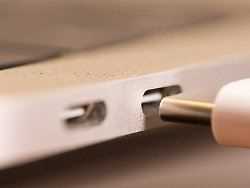Intel introduces Thunderbolt 4. The new interface is no faster than the current generation, but is still a big step forward. Because Thunderbolt 4 puts an end to the current USB chaos by combining all possible standards.
Anyone who buys a new notebook these days has to look very carefully at which USB ports the device has. Because with USB-A and USB-C there are not only two different connections, but several USB standards that have very different capabilities, but are difficult to tell apart. In the near future, this should change with Thunderbolt 4, which in principle will be the better USB 4.
Complicated USB variety
Since the introduction of USB 3.1, the USB confusion is huge. Because what used to be USB 3.0 was only renamed USB 3.1 Gen 1 and has now been called USB 3.2 Gen 1 since USB 3.2 was launched, which is officially called USB 3.2 2×2. And then there is also the Thunderbolt 3 developed by Intel in cooperation with Apple. There are currently quite a number of different USB names in parallel, which differ mainly in the transmission speeds:
- USB 3.0 / USB 3.1 Gen 1 (5 GBit / s)
- USB 3.1 Gen 2 (10 Gbit / s)
- USB 3.2 Gen 1 x 1 (5 Gbit / s)
- USB 3.2 Gen 2 x 1 (10 Gbit / s)
- USB 3.2 Gen 2 x 2 (20 Gbit / s)
- Thunderbolt 3 (40 Gbit / s)
With USB 4.0, which was announced in spring 2019, the interface madness should come to an end. In principle, it is based on Thunderbolt 3, which Intel makes available for this purpose without a license. Among other things, USB 4.0 also offers a maximum speed of 40 Gbit / s and is backwards compatible with USB 3.2 and 2.0, which makes things much easier.
Higher minimum requirements than USB 4
Thunderbolt 4 adds one more. The new interface not only fully complies with the USB 4 specifications, but also offers more functions and sets the bar a bit higher for the minimum requirements. According to Intel, devices for certification must meet the following requirements:
- Video and data: The interface must allow the connection of two 4K displays or an 8K display, data must be able to be transferred to PCI Express connections at up to 3 gigabytes per second (GB / s).
- Support for docks with up to four Thunderbolt 4 ports.
- Charging batteries on at least one computer port.
- Computers connected to a Thunderbolt dock wake up when the keyboard or mouse is touched.
- So that hackers cannot use the interface's direct access to the working memory for attacks, it must support Intel's VT-D-based DMA protection (Direct Memory Access).
Apple is on board
Intel's upcoming mobile processors, code-named "Tiger Lake", will be the first to integrate Thunderbolt 4. Intel expects computers and accessories with the new interface this year.
After Apple announced at WWDC that it would use its own ARM chips in its Mac computers, it was initially unclear whether the manufacturer would be in the Thunderbolt 4 boat. But a company spokesman assured "The Verge" that the upcoming Apple computers would support the new standard.
. (tagsToTranslate) Technology (t) Computer (t) Intel (t) Apple
